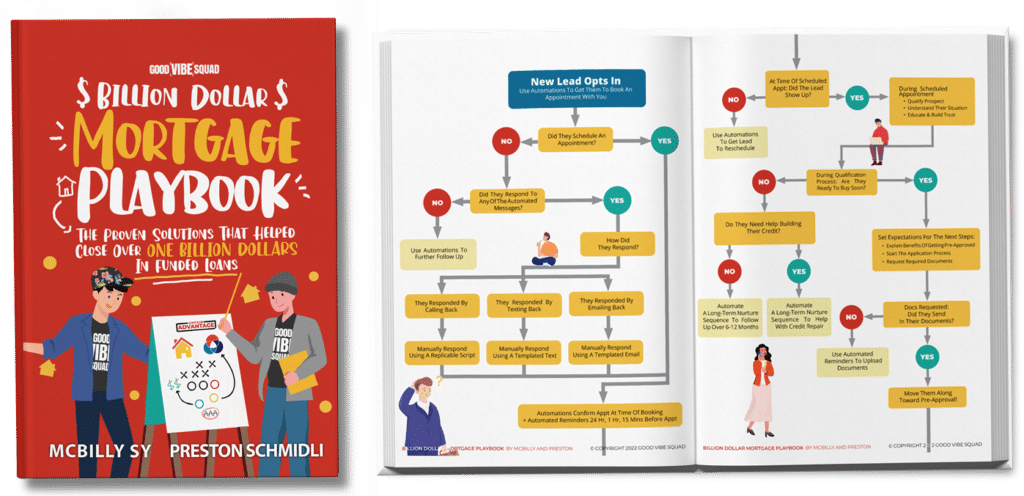One of the most challenging aspects of working in the mortgage loan industry is keeping up a steady flow of leads. After all, without a solid lead pipeline, you will not be able to grow or sustain your business.
To ensure you maintain proper lead-generating channels, you need to invest in tried-and-true methods that help you keep them coming in. One such mortgage marketing strategy is having a website designed specifically for generating leads.
This article will not discuss finer starting points of the technical details that create a website, like setting up domain names or hosting. Instead, it will instruct you on the importance of lead-generating sites, how to design a site with lead generation in mind, the usefulness of mortgage CRMs, and a few key tips you can use now to increase your mortgage leads.
Key Takeaways
- A lead generation website is a specific website designed to help attract, nurture, and convert potential leads through quality content marketing.
- While the goal of a great lead generation website is to provide quality content that is unique to your services and the mortgage industry, there are some key components, such as a clear call to action, of CTA, that must be included in your lead generation website design.
- Once you define your target audience and their conversion points, it is essential that you create content that addresses the three standard conversion paths: TOFU, MOFU, and BOFU.
- Whether you are an established loan officer or just starting out with a new business, creating a quality lead-generation website can make all the difference in your business’s success.
Get Our Billion Dollar Mortgage Playbook
Get the proven strategies that helped close Billions of dollars in funded deals!
What is a lead generation website?
A lead generation website is a site that teaches visitors about the specific products and services your mortgage business provides while simultaneously collecting useful data about site visitors.
This is highly advantageous because it gives your business the opportunity to inform potential clients about your services, thereby growing customer retention.
Additionally, it provides your sales teams with the data they need to market to the right audiences and make sure they are hitting the right pain and selling points for your customers.
What makes a good mortgage lead generation website?
In today’s digital world, chances are your business already has a website. But is that website truly working for you? While you may attract a new lead on occasion, if your website is not bringing in a steady flow of leads, then it is not truly working for you. Here we highlight some key components that can turn your current website into a true lead-generation tool.
User experience
When creating a lead generation website, you need to put yourself in your first-time visitor’s shoes and create a website that provides a quality user experience. This can include everything from a clean, professional-looking design and easy navigation, to providing content that clearly addresses your target audience’s pain points.
Professional design
No matter how much quality content you offer on your website, the basic design and flow can make all the difference. How many times have you visited a website that was difficult to navigate and filled with clutter? Did you stay on that site or move on to the next listing in the search engine? Even though that site may have had all the information you needed, chances are you moved on to the next one that was easier to navigate.
When creating a quality lead generation website, you want to create a clear, clean, and easy-to-use navigation that reflects your business and your brand. Avoid clutter and make sure that your message and information are approachable to all users. And don’t forget your mobile users. These days, many people use smartphones to access a major portion of their internet searches. When designing your website, ensure that it is mobile-friendly and provides mobile users with a quality user experience. This can help boost your overall lead conversion.
Clear Call to Action
A call to action, or CTA, is a prompt designed to inspire your target audience to take a desired action. When creating your specific CTA, it is recommended to provide a clear CTA that defines what exactly you want. For example, many companies use the standard “Contact Us” CTA. While this can be effective, it is very vague and does not clearly express a defined action. Instead, consider using more straightforward CTAs, such as “Book a Free Credit Evaluation” or “Apply for a Pre-Qualification Today.” These CTAs offer a clearer picture of what they can expect and can help increase your overall conversion rate.
Strong value proposition
The mortgage industry is a highly competitive market, and in order to stand out above your competition, you need to offer a strong value proposition. A strong value proposition focuses on what your business has to offer that may be different than other local loan officers and how your mortgage business is able to uniquely address their needs where others may not.
Easy navigation
As we have mentioned before, the goal of a lead generation website is to provide a valuable user experience that allows visitors to easily find the information they need. The best way to ensure this is to provide a clear and easy-to-find page navigation system. Whether this includes buttons, linked text, or drop-down menus, it is essential to make sure they are easy to find and not lost in the rest of your page design. Consider having friends or family evaluate your design first, asking them to rate not only the basic design but their ease in navigating your website.
Relevant content
The key to keeping a potential lead on your website is offering quality, relevant content. By providing quality information and addressing their potential questions, you begin building trust in your brand and increasing the likelihood of a conversion.
How do you create a mortgage lead generation website?
You must consider two steps before creating a mortgage lead-generating website: creating the system and creating conversion paths. Each of these comes with a list of steps you need to follow.
But there is a key factor that needs to be established before you can make any other decisions about your site: determining your audience. After all, if you don’t know who your audience is, how will you know who to market to? And how will you know which methods will work best on your target demographics if you don’t know which people make up those groups? Take some time to carefully consider your audience before delving into these lead-generating, site-building tips.
Create a system
The goal of any good mortgage lead-generating website is to draw in new visitors and boost conversion rates. To do this, you need to set up a solid, workable system that brings in and retains as many visitors as possible. Fortunately, there are several different systems you can use.
- Traffic source: The primary source for how people find your website or company in the first place. It can be through referrals, social media, Google ads, Google My Business, or any number of other sources.
- CTA: A CTA or “call to action” is a straightforward instruction that potential customers are given upon viewing your site or reading an article. It urges them toward an action that you want them to take.
- Inquiry form: It is how a website collects customer information and leads by prompting readers to fill out their names, contact information, and other personal details that can automatically transfer into your mortgage CRM.
Create conversion paths
Once you have your lead-generating system in place, you need to build solid conversion paths to move potential customers from the window-shopping stage and closer to the purchasing stage of their business relationship with you. There are three standard conversion path stages that you can use to build strong systems for your mortgage lending company.
- TOFU, or top of the funnel, is the awareness stage of a buyer’s interaction with your company. It’s where they first become aware of their problem, research it, and find your business among their preliminary research. For this stage, you need to make sure you provide enough valuable content to feed your potential clients’ research.
- MOFU, or the middle of the funnel, is where clients consider the specific mortgage lending solutions you provide, and they are actively researching specific solutions. You need to continue providing a lot of information at this stage because potential clients are still not ready to buy yet. Take the chance to unforcefully guide them toward using your company’s services through quality content marketing.
- BOFU, or the bottom of the funnel, is where clients decide to make a purchase or not. These researchers rely on brands and specific products. In this stage, you need to make sure that you sell your services as much as you can. Show clients why they should work with you and make your brand stand out.
Website and CMS
Web-building services are incredibly handy, but they come in cookie-cutter formats that leave little room for a business’ self-expression or personality to show through, not to mention all the technological amenities that are missed out on.
If you want your business’ website to truly stand out and help you bring in as many viable leads as possible, you need to invest in a strong, customized website with a built-in content management system (CMS). When you invest in customized services, all the site functions will be rooted in the needs of your specific business, not the potential generic needs of any number of sites.
Best practices for mortgage lead generation websites
In addition to offering quality information and a comfortable user experience, there are other components that are essential to the success of lead generation through your website. Here we look at some of those components and how they benefit your business.
Optimized for search engines (SEO)
You could have the best-designed website that offers an engaging experience while providing superior content, but if a user can’t find you, it provides no benefit at all when it comes to lead generation. Search engine optimization, or SEO, is essential to ensure new visitors can find your website when they search for specific keywords. Aside from hiring an SEO specialist, there are some things you can do to help boost your presence in the search results. These can include:
- Publish original, quality content to your website and/or blog
- Make sure your website has page titles and descriptions used by the search engines
- Include internal links as well as backlinks: Internal links connect one page in your website to another. For example, if you have a blog post on a specific topic, such as credit reports, link to that blog from another page on your site. Backlinks are links on other sites that link to your website, such as Google Business Profile, formally called Google My Business.
- Create a Google Business Profile. This profile provides you with a Google business listing and creates a backlink to your website. This helps to increase your click-through rate. This profile also helps to boost local SEO.
Include testimonials
Surveys show that 95% of consumers read online reviews before purchasing a product or service and as much as 58% of them say they would be willing to pay more for a brand with better reviews. Ask satisfied customers if they would be willing to provide reviews and be sure to include these reviews on your website, as well as your Google Business Profile.
Offer lead magnets
Lead magnets are a marketing tool that helps generate new leads by offering an incentive for a visitor’s contact information. For example, if you are a loan officer that targets first-time homebuyers, then a good lead magnet may be a simple downloadable guide created by you that walks them through the loan process, defines common industry terms, and helps them determine how much home they can really afford.
Use landing pages
A landing page is often a stand-alone page designed specifically for a marketing or advertising campaign. For example, if your target audience is first-time homebuyers and you plan to target them in a marketing campaign, you can design a landing page to match and provide information that caters to the campaign. Whether it is an email campaign or a social media marketing campaign, you can include a direct link to the specific landing page. Directing leads to these pages allows you to see where they came from, and which marketing efforts are working best.
Implement lead capture forms
The goal of your website is lead generation, so you want to be sure there is an easy way to get contact from your visitors. Offering a lead capture form on your website allows them to supply information, request contact, or can be connected to your lead magnet. Connecting your lead capture form directly to your mortgage CRM allows automatic transfer of this information once submitted and enters them into your sales funnel.
Tips on increasing mortgage leads
There are many ways you can increase the number of leads that visit your website. Let’s take a closer look at the three top methods:
- Use proper keyword research for each page for organic traffic and inquiries.
- Create content around those keywords. Typically, you should invest in building up informational content that teaches potential leads about the topics they’re researching. This gives you credibility and builds lead loyalty.
- Properly motivate your audience with CTA buttons. If your audience doesn’t feel inspired to take action after seeing your CTA button, you need to change it to inspire a stronger response. Popular CTAs that are used today include “Learn More,” “Save Now,” “Subscribe,” and “Get Started.”
Invest in a lead-generating website today!
Building the best mortgage lead-generating website for your business takes a lot of work, but it’s the only way to bring in a full pipeline of leads to sustain and grow your business. Take the time to invest in proper strategies and systems that will push you toward success, and pay careful attention to each step in the TOFU/MOFU/BOFU processes.
One key strategy you can use to attract the right customers, automate as many processes as possible, and then amplify all of the results to expand your business is by using an Unfair Advantage designed to help you through each of those steps!
Schedule a call with us to learn more about mortgage lead-generating websites.







